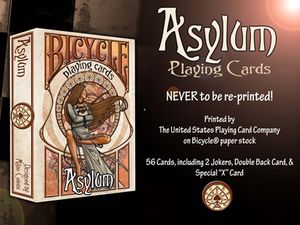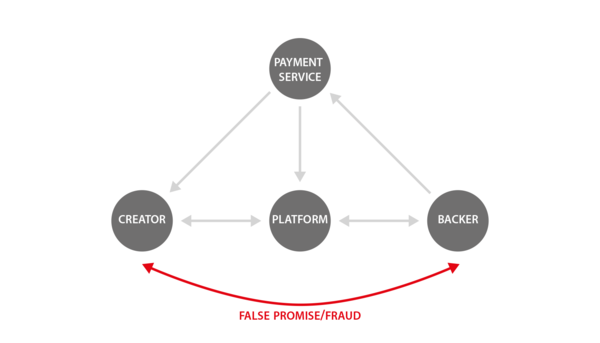Difference between revisions of "Fraud and False Promise"
(→Creator fraud) |
|||
| Line 10: | Line 10: | ||
==Creator fraud== | ==Creator fraud== | ||
| − | With a crowdfunding campaign creators ask for money from backers. In cases of fraud by creators, they are deliberately misleading the backers about the project or the expected outcomes. Creators launch an unexisting project with no intention of developing it. They post fake news, photos and make up positive | + | With a crowdfunding campaign creators ask for money from backers. In cases of fraud by creators, they are deliberately misleading the backers about the project or the expected outcomes. Creators launch an unexisting project with no intention of developing it. They post fake news, photos and make up positive customer feedback, tweets, etc. |
| − | “Stillborn Fraud” occurs when a campaign which is submitted for launch is summarily rejected by the | + | “Stillborn Fraud” occurs when a campaign which is submitted for launch is summarily rejected by the platform. While campaigns are rejected for a variety of reasons ranging from technical errors to merely being incomplete, there are certainly many that get rejected because they carry a risk of fraud. They are filtered out before they are ever launched. Crowdfunding platforms avoid suspicious projects as they can be damaging its reputation badly. <ref> [http://www.crowdfundinsider.com/2014/03/34255-crowdfunding-fraud-big-threat/ Crowdfunding Fraud: How Big is the Threat?] Downloaded on Nov. 28, 2014 </ref> |
| − | In cases of “attempted fraud” a creator will try to use a crowdfunding | + | In cases of “attempted fraud” a creator will try to use a crowdfunding platform to attract money from unsuspecting backers. They are good examples of how the transparency and public nature of crowdfunding platforms attract these attempts at fraud. The effect of the Wisdom-of-the-Crowd does an effective job of “outing” most attempts before money changes hands. |
| − | The | + | The platform shuts down a suspicious crowdfunding campaign before any money is transferred. It is often discovered by members of the site, many of which are just and not necessarily backers. Discussion often happens in public forums and platform administrators are alerted. In these cases, the nature of fund exchange proved an important safeguard for those backing a campaign. <ref> [http://www.crowdfundinsider.com/2014/03/34255-crowdfunding-fraud-big-threat/ Crowdfunding Fraud: How Big is the Threat?] Downloaded on Nov. 28, 2014 </ref> |
| Line 21: | Line 21: | ||
[[File:2A_KobeBeefJerky.jpg|thumb|Kobe Beef Jerky <ref> [https://www.kickstarter.com/projects/kobered/kobe-red-100-japanese-beer-fed-kobe-beef-jerky?ref=nav_search KOBE RED - 100% JAPANESE BEER FED KOBE BEEF JERKY] Downloaded on Dec. 5, 2014 </ref>]] | [[File:2A_KobeBeefJerky.jpg|thumb|Kobe Beef Jerky <ref> [https://www.kickstarter.com/projects/kobered/kobe-red-100-japanese-beer-fed-kobe-beef-jerky?ref=nav_search KOBE RED - 100% JAPANESE BEER FED KOBE BEEF JERKY] Downloaded on Dec. 5, 2014 </ref>]] | ||
On crowdfrauds.com the article “Kobe Beef Jerky – Biggest Crowdfunding Scam Yet?” talks about such a fraud from a creator. This case is referred as “one of the biggest frauds in Kickstarter’s history.” The backers luckily discovered the scam just in time. <ref> [http://crowdfrauds.com/uncovered/biggest-crowdfunding-scam-yet/ Kobe Beef Jerky – Biggest Crowdfunding Scam Yet?] Downloaded on Nov. 27, 2014 </ref> | On crowdfrauds.com the article “Kobe Beef Jerky – Biggest Crowdfunding Scam Yet?” talks about such a fraud from a creator. This case is referred as “one of the biggest frauds in Kickstarter’s history.” The backers luckily discovered the scam just in time. <ref> [http://crowdfrauds.com/uncovered/biggest-crowdfunding-scam-yet/ Kobe Beef Jerky – Biggest Crowdfunding Scam Yet?] Downloaded on Nov. 27, 2014 </ref> | ||
| + | |||
| + | The creator promoted his project by telling that he loved the taste of Kobe Beef jerky. He had learned to make jerky on his uncle’s farm in Japan. Moving to U.S. he was no longer able to find good jerky. Japan had banned an export of this refined meat. On several events he gave out free samples of jerky. The good responses encouraged him to launch the campaign in May 2014. | ||
| + | |||
The project quickly raised more than $120,000 in funding, nearly 50 times the campaign’s financing goal. That is when backers and other members of the site began to grow suspect. The scam started to unravel when the “Kickstarter documentarians” hired a private investigator to look into the campaign’s creator, Magnus Fun Inc.. They found several strange details about the company and published their findings. Soon after, suspicions went viral, and users began to flag the campaign. Kickstarter eventually shot the project down, before its conclusion and prevented an astronomical fraud of $120,309. <ref> [http://www.supercompressor.com/gear/kickstarter-frauds-worst-crooks-in-crowdfunding Kickstarter Crooks: The Biggest Frauds In Crowdfunding] Downloaded on Nov. 27, 2014 </ref> | The project quickly raised more than $120,000 in funding, nearly 50 times the campaign’s financing goal. That is when backers and other members of the site began to grow suspect. The scam started to unravel when the “Kickstarter documentarians” hired a private investigator to look into the campaign’s creator, Magnus Fun Inc.. They found several strange details about the company and published their findings. Soon after, suspicions went viral, and users began to flag the campaign. Kickstarter eventually shot the project down, before its conclusion and prevented an astronomical fraud of $120,309. <ref> [http://www.supercompressor.com/gear/kickstarter-frauds-worst-crooks-in-crowdfunding Kickstarter Crooks: The Biggest Frauds In Crowdfunding] Downloaded on Nov. 27, 2014 </ref> | ||
Revision as of 01:08, 17 December 2014
The following article deals with fraud in crowdfunding. See the main article for an overview of the Disputes in Crowdfunding.
Fraud is a deception deliberately practiced in order to secure unfair or unlawful gain. [1] Since crowdfunding is becoming mainstream, the potential for fraud is increasing. In order for crowdfunding to become a viable and lasting means of funding for emerging companies, fraud has to be limited; unsuspecting contributors, donors and investors must be protected. [2] In crowdfunding one can differentiate between three major types of scams: fraud by creators, fraud by backers and false promises from creators.
Contents
Creator fraud
With a crowdfunding campaign creators ask for money from backers. In cases of fraud by creators, they are deliberately misleading the backers about the project or the expected outcomes. Creators launch an unexisting project with no intention of developing it. They post fake news, photos and make up positive customer feedback, tweets, etc.
“Stillborn Fraud” occurs when a campaign which is submitted for launch is summarily rejected by the platform. While campaigns are rejected for a variety of reasons ranging from technical errors to merely being incomplete, there are certainly many that get rejected because they carry a risk of fraud. They are filtered out before they are ever launched. Crowdfunding platforms avoid suspicious projects as they can be damaging its reputation badly. [3]
In cases of “attempted fraud” a creator will try to use a crowdfunding platform to attract money from unsuspecting backers. They are good examples of how the transparency and public nature of crowdfunding platforms attract these attempts at fraud. The effect of the Wisdom-of-the-Crowd does an effective job of “outing” most attempts before money changes hands. The platform shuts down a suspicious crowdfunding campaign before any money is transferred. It is often discovered by members of the site, many of which are just and not necessarily backers. Discussion often happens in public forums and platform administrators are alerted. In these cases, the nature of fund exchange proved an important safeguard for those backing a campaign. [4]
Kobe Beef Jerky

On crowdfrauds.com the article “Kobe Beef Jerky – Biggest Crowdfunding Scam Yet?” talks about such a fraud from a creator. This case is referred as “one of the biggest frauds in Kickstarter’s history.” The backers luckily discovered the scam just in time. [6]
The creator promoted his project by telling that he loved the taste of Kobe Beef jerky. He had learned to make jerky on his uncle’s farm in Japan. Moving to U.S. he was no longer able to find good jerky. Japan had banned an export of this refined meat. On several events he gave out free samples of jerky. The good responses encouraged him to launch the campaign in May 2014.
The project quickly raised more than $120,000 in funding, nearly 50 times the campaign’s financing goal. That is when backers and other members of the site began to grow suspect. The scam started to unravel when the “Kickstarter documentarians” hired a private investigator to look into the campaign’s creator, Magnus Fun Inc.. They found several strange details about the company and published their findings. Soon after, suspicions went viral, and users began to flag the campaign. Kickstarter eventually shot the project down, before its conclusion and prevented an astronomical fraud of $120,309. [7]
Backer fraud
Fraud in crowdfunding is not limited to project creators. There has been at least one reported case where contributors deliberately pledged money to crowdfunding campaigns with the intent to withhold the funds or to file a claim to get their money refunded. [8] The backer normally pledges a high amount. After the campaign was successfully funded and once rewards had been shipped, he rescinds his money through credit card chargebacks, receiving both the reward and the money. These cases are very difficult to bring to court because the backer can easily stay anonymous. But the damage for creators can be immense. Officially their project got funded, so they have to provide their backers with their product.
Victims of Backer Scam
A Kickstarter donor, Encik Farhan, appears to have been pledging large amounts of funds, only to withdraw the cash after he received the rewards. Farhan used a system known as the credit card chargeback, scamming more than 100 Kickstarter project owners in the process. Farhan just changed the way that Kickstarter operates its funding and rewards program. The credit card chargeback was created to protect buyers from fraud and merchant negligence. The credit card company investigates, and in most cases, the credit card owner gets his money back. When a chargeback is rendered, the bank immediately refunds the proceeds to the winning party. [9] [10] [11]
False Promise
In case of a false promise project creators fail to deliver the promised reward to the backers after they donated money through their crowdfunding campaign. Often these cases are not brought to court because the money each backer invested is not worth the effort.
In the Terms of Use of Kickstarter is written” if a creator is unable to complete their project and fulfill rewards, they’ve failed to live up to the basic obligations of this agreement. To right this, they must make every reasonable effort to find another way of bringing the project to the best possible conclusion for backers.” [12] This reasonable effort includes also posting updates on the platform what work has been done, how the funds are being used, and what prevents them from finishing the project as planned and they offer to return any remaining funds to backers who have not received their reward (in proportion to the amounts pledged), or else explain how those funds will be used to complete the project in some alternate form. And later on: “The creator is solely responsible for fulfilling the promises made in their project. If they’re unable to satisfy the terms of this agreement, they may be subject to legal action by backers.” [13]
Asylum Playing Cards

This dispute is apparently the first consumer protection lawsuit involving crowdfunding. The project was launched on Kickstarter in 2012 and was funded successfully by 810 backers. Over two years passed after the completion of the Kickstarter campaign and the transmission of the funds but not a single consumer had received the promised reward. The Kickstarter campaign raised funds to create a set of Asylum playing cards, and the campaign promised the retro-horror-themed playing cards, posters and signed sketches from a Serbian artist as rewards. In May 2014 the attorney general for the state of Washington filed a lawsuit against Altius Management and owner Edward Polchlepek III, also known as Ed Nash. Several backers tried to contact the project creator over the two years. Kickstarter’s terms of use require creators to fulfill all rewards of their projects or refund backers. Backers have a legal recourse if creators do not fulfill their promises. [15]
References
- ↑ fraud Downloaded on Nov. 27, 2014
- ↑ Crowdfunding Fraud: How Big is the Threat? Downloaded on Nov. 28, 2014
- ↑ Crowdfunding Fraud: How Big is the Threat? Downloaded on Nov. 28, 2014
- ↑ Crowdfunding Fraud: How Big is the Threat? Downloaded on Nov. 28, 2014
- ↑ KOBE RED - 100% JAPANESE BEER FED KOBE BEEF JERKY Downloaded on Dec. 5, 2014
- ↑ Kobe Beef Jerky – Biggest Crowdfunding Scam Yet? Downloaded on Nov. 27, 2014
- ↑ Kickstarter Crooks: The Biggest Frauds In Crowdfunding Downloaded on Nov. 27, 2014
- ↑ Crowdfunding Fraud: How Big is the Threat? Downloaded on Nov. 28, 2014
- ↑ Can a Crowdfunding Platform Really Protect You From Fraud? Downloaded on Nov. 27, 2014
- ↑ Kickstarter Crooks: The Biggest Frauds In Crowdfunding Downloaded on Nov. 27, 2014
- ↑ Victims Of Backer Scam Vent On Kickstarter Forum, Allege Over 150 Campaigns Affected Downloaded on Dec. 5, 2014
- ↑ Terms of Use Downloaded on Nov. 27, 2014
- ↑ Terms of Use Downloaded on Nov. 27, 2014
- ↑ Asylum Playing Cards Downloaded on Dec. 5, 2014
- ↑ First-of-a-kind Kickstarter lawsuit highlights risks of crowd funding Downloaded on Nov. 28, 2014
